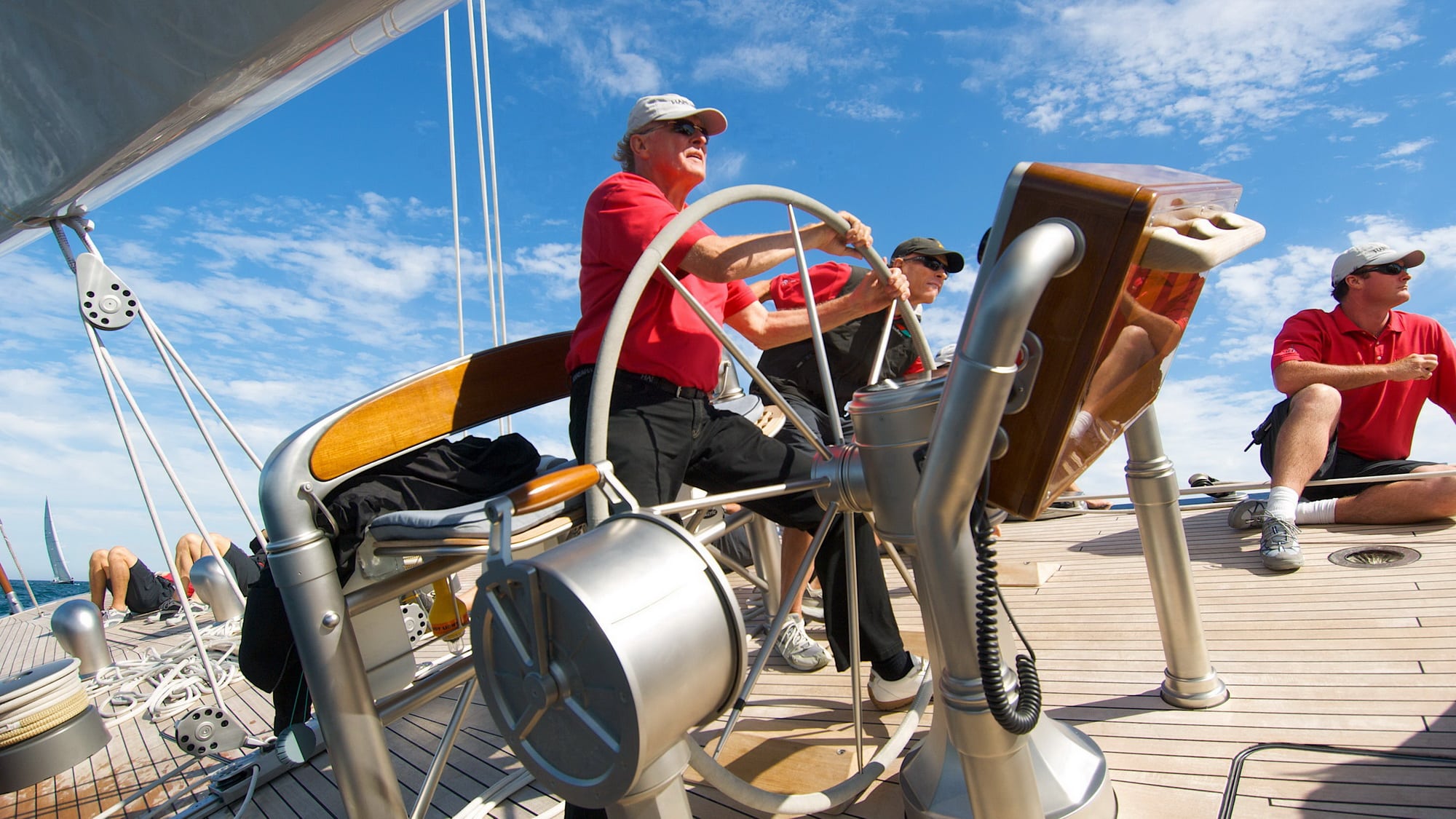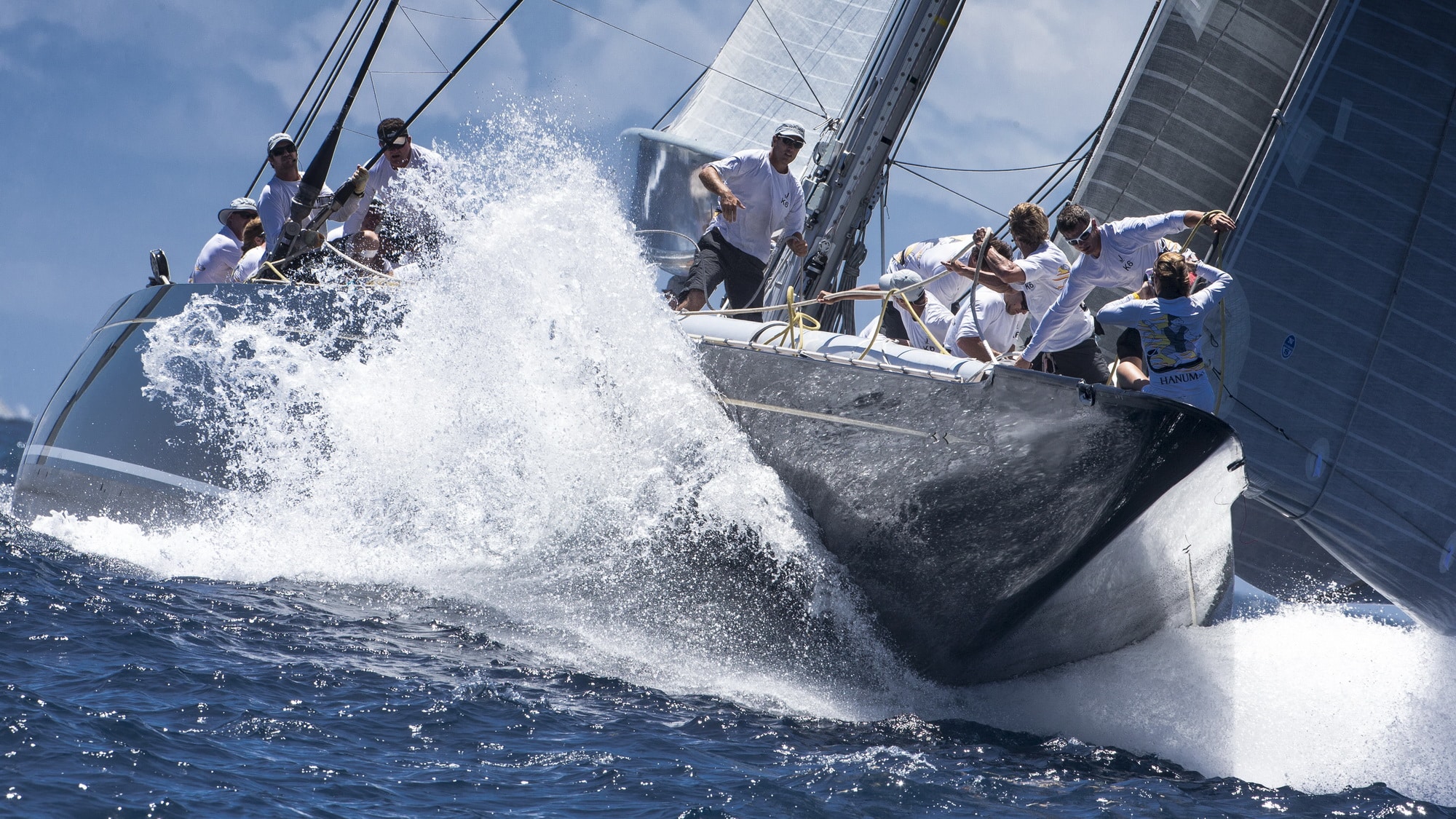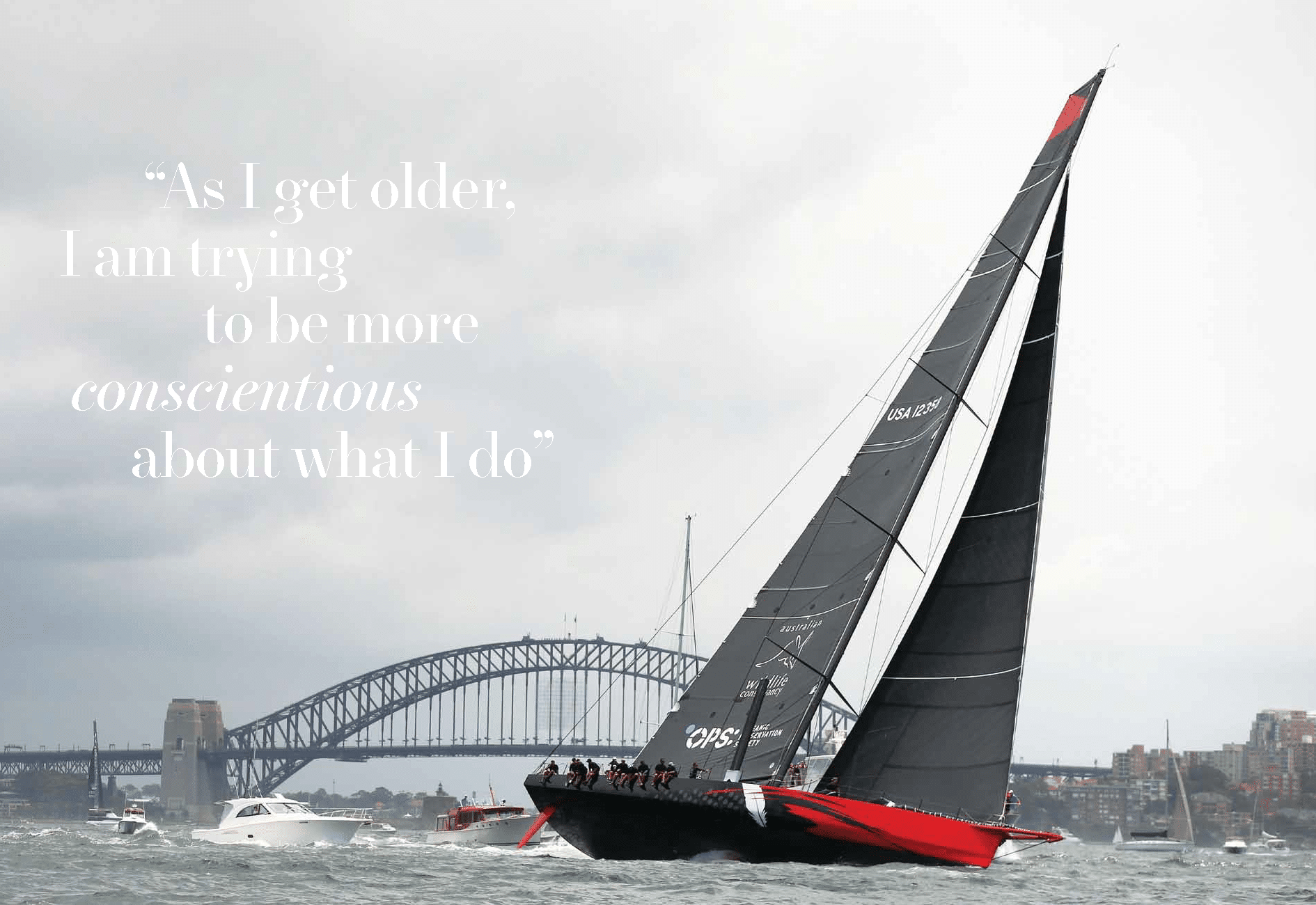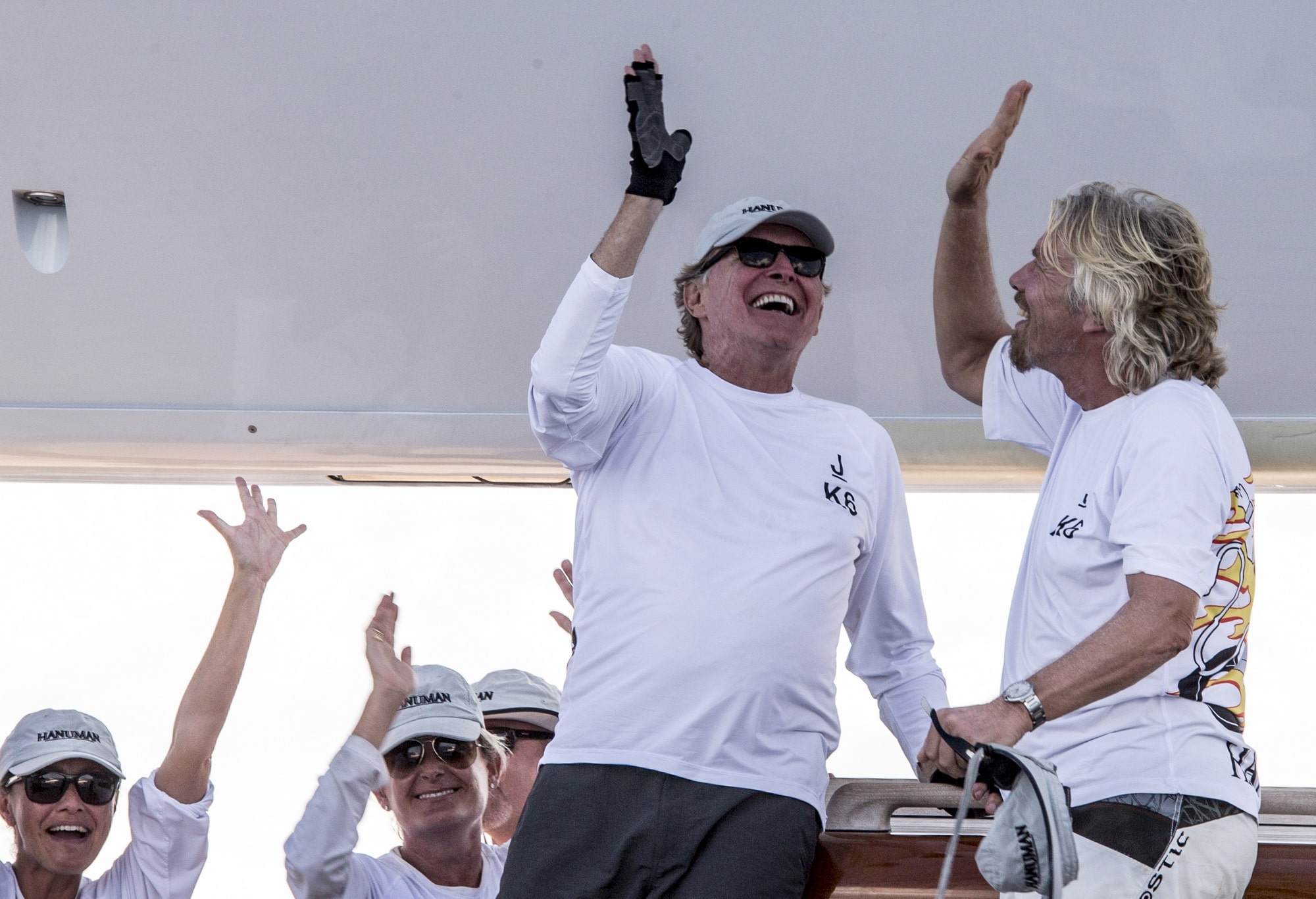Serial entrepreneur and superyacht builder Jim Clark isn’t a bad person to talk to if you’re looking for insights into the art of truly living…
LIVING THE LIFE WITH JIM CLARK
LIVING THE LIFE WITH JIM CLARK
12 May 2015Article by Jill Bobrow for The Superyacht Life Magazine (71 Percent, issue 2, 2015): read full text below. Captions of above page 1: world beater Jim Clark aboard his globe-trotting, trend-setting megayacht Athena. Page 2: the romance of boats Clark’s ‘starter yacht’ Hyperion; together with wife Kristy Hinze and daughter Dylan. Page 3: a different rhythm Clark with Ben Stiller at the New York premiere of The Cove in 2009; with wife Kristy Hinze for a rare night in the spotlight in Sydney in 2010.
Defining art is an elusive proposition. Identifying an artist is a bit easier. An artist is a person who does not fit the status quo, someone who sees what we don’t see and who views the world from his or her own unique perspective. Society both hates and loves an artist. Artists are often individuals who don’t tow the line, who don’t fit into the cultural norm, and who are simply not conventional. Artists open us up to new ideas, whether it is fashion, fine art, architecture, or even new technology.
Guys like Jim Clark are part of what keeps society evolving and growing. Clark may not be an artist in the classic sense – he’s not a painter or a sculptor. He’s a science geek whose life’s work has been a trajectory of creativity and ‘out of the box’ thinking. Like an artist, Clark lives his life in a certain manner as a result of the way he sees things. That life has evolved from rebellious teenager to engaged student to physicist to computer scientist to teacher to inventor to high-tech entrepreneur to businessman to yacht designer to philanthropist to dedicated family man.
“hopefully I am not
the narrow engineer
I once was”
Tall, with tousled golden hair and a disarming smile, Clark is a 70 year old who looks and acts younger than his years – a veritable Peter Pan who exudes a youthful enthusiasm for myriad subjects. The quintessential selfmade man, Clark was a high-school dropout who ran off to the navy at 17, eventually working his way through correspondence courses and university to attain PhDs in physics and computer science.
Jim Clark at the helm of his J-class Hanuman, the modern recreation of Endeavour II
Famous as the founder of Netscape Navigator, Silicon Graphics, myCFO, and Healtheon/WebMD, as well as being the investing founder of Shutterfly, Clark also developed the 3D computer imagery that enabled Spielberg to create the special effects in Jurassic Park. In 1999, four years after launching the first mass-market browser for the World Wide Web with Marc Andreessen, Clark and Andreessen sold Netscape to America Online and reaped several billions. Business begets business, and Clark, a serial entrepreneur, continued to work on new projects while making astute and timely investments in Apple, Facebook and Twitter.
The common thread through all this has been Clark’s ability to see things in new ways. Today, he says, “I am no longer connected to the core of what is happening in Silicon Valley, nor do I fit in any more.” Yet, he is still active in computer science and in developing new software. It’s in his DNA to explore new concepts. Conversing with Clark about his conceptual work can be a bit daunting, so much so that one wonders if sometimes people are intimidated by trying to make conversation with him at social functions. He responds with a story about how – on the contrary – he has felt out of his element on various occasions. There was a dinner party at the home of Diane Sawyer and Mike Nichols… “I gave Diane and Mike a lift on my plane to London years ago,” Clark says. “Later, they invited me to stay at their home in Martha’s Vineyard. At dinner, there were several notable people at the table including Carly Simon. Among the guests was a venerated writer who everyone knew except me. I had never heard of any of his books. I could not contribute to the animated conversation and felt a bit out of my depth. The author was William Styron. I rarely read works of fiction, but later I made a point of reading The Confessions of Nat Turner. I thought it stunningly well done, so I proceeded to read other Styron books. Years later, I ran into Diane and Mike aboard Larry Ellison’s boat and told them how I had finally read Styron and would love to chat with him. They encouraged me to come back to the Vineyard and they would arrange another meeting. Time went by and I never made it back. Then Styron passed away. It was a lost opportunity.”
Jim Clark is a man who has made an art of not missing opportunities. His ability to sense what the next hot thing will be in technology, computer science and related businesses has made him famous and wealthy. Michael Lewis’s best-selling book The New New Thing: A Silicon Valley Story, published in 1999, focused on Clark, the internet boom and, to some degree, on the sailing yacht Clark was building at the time – the revolutionary Hyperion. Clark was very much involved in the concept and technology of this 47m cutter-rigged sloop, built in the Netherlands. Designed to operate with the assistance of 28 computers, this yachting tour de force was not only beautiful but sailed well enough to win first place in the 2001 Millennium Cup in New Zealand. A ‘starter yacht’, Hyperion was sold by Clark and he was on to the next new thing. In the past dozen years or so, he has conceived and built three more extraordinary yachts.
Clark dislikes the word ‘yacht’ himself. “I think the word has a snobby connotation,” he says. “I prefer to think of them as boats.” His next two boats were the 90m Athena and the 42.1m J-Class Hanuman. As with Hyperion before her, Athena was a first. Launched in 2005, She led the trend for mega-sailing yachts. “She was an exercise in aesthetics and practicality,” Clark says. “I wanted a sizable yacht to sail around the world. I am tall, so I need lots of standing headroom and wanted two decks with lots of living space.” He spent six to seven years sailing her extensively. He loved being able to share his boat with others, taking friends such as Liev Schreiber, Naomi Watts and Fisher Stevens on unique, exotic sailing trips.
“I think the word yacht
has a snobby
connotation.
I prefer to think
of them as boats”
At the same time he was sailing Athena, Clark became fascinated with the romance of building and owning a J-Class yacht – and saw an opportunity to do it his way. In 2009, Hanuman, an exquisite modern classic was launched. This sleek needle of a yacht is as fine a specimen of its type as one can find afloat, albeit that there are only seven J-Class yachts in the world. After Hanuman, however, Clark opted to retire from “playing in the J-Class racing circuit” – a game with rules, stipulations and internal politics. Clark doesn’t like rules. He put out a challenge to the other J-Class owners, suggesting they each commit to putting up a similar amount of money for sea conservation or their favourite charity as they put into their individual races. There were no takers.
Clark’s most recent state-of-the-art yacht is the 30m Comanche. Launched last September in the US, she is an all-carbon-fibre ocean racer – a very sexy machine. “My goal in building her was to build the fastest, most high-tech boat possible,” he confesses. Comanche has already competed in the likes of the Rolex Sydney Hobart race, but without Clark aboard. These days, he prefers to partake from the comfort of his sofa on his iPad, utilising software he invented. “I wrote a vital robust operating system for the boat,” he says. A few years ago, Clark told the Wall Street Journal that he was putting Athena and Hanuman on the market because he was venturing into a new phase of his life, one that corresponds with his six-year marriage to Australian model and TV hostess Kristy Hinze. With two small children at home – a three year old and a new baby – Clark is much more land-based these days. However, if Athena does not sell for his price, he does not discount the idea of taking his young daughters sailing when they are at the appropriate age to benefit from travelling to places he loves to visit such as Tahiti and New Guinea.
“As I get older,
I am trying to be
more conscientious
about what I do”
But for now, Clark’s sweet spot is home sweet home. He has moved on from his edgy, workaholic years and now enjoys living life at his own relaxed rhythm. “I get up at 4am and programme around on my computer until Kristy texts me that the kids are up,” he says. “At around 7.30am I join her in the nursery and help get Dylan ready for pre-school. I also spend time with baby Harper. Next, I work out, and after that I have breakfast around 10.30. Then I delve into some work projects until late afternoon.” Clark knocks off early for quiet time with a civilised glass of wine and then he engages in more family time – his nighttime ritual of reading to Dylan is a priority. He and Hinze enjoy evenings with good friends although, for the most part, Clark says, he is usually in bed early.
Money does not particularly motivate him, though he admits it is handy to support his lifestyle. He has a beautiful home in Palm Beach, a horse farm elsewhere in Florida, a house in New York state on the border with Connecticut and is renovating a townhouse in New York City. He flies privately, has a hearty wine cellar and enjoys a vast art collection including paintings by Matisse, Picasso, Manet and Lautrec. He does not collect for the sake of collecting – his artwork is on his walls to enjoy, his wine is for drinking and entertaining others. “I believe it is really important to have an appreciation for art and for the humanities as well as science,” he says, before harking back to the William Styron story and adding, “Hopefully I am not the narrow engineer I once was.” Today, Clark sees himself as being in a new phase of his life. “As I get older, I am trying to be more conscientious about what I am trying to do and what I do,” he says. It was this that motivated him to become one of the backers for the Academy Award-winning documentary film The Cove, a vivid exposé of dolphin-hunting practices in Japan. He has also made the largest donation to Stanford University since its founding. Together, Clark and Hinze are very involved in animal rights as well as nature organisations. “We all have a responsibility to do our part,” he says. While he admits to expending more than his fair share of fossil fuels, he also works hard to offset his carbon footprint.
Clark is explicitly concerned about the health of the world and about the long-lasting effects of climate change. “There are fools out there claiming that global warming is a hoax. That is absolutely crazy,” he says. “There is no question that human activity is responsible for the emission of most greenhouse gases in the atmosphere. What motivation would pure scientists and Nobel-prize winners have for spreading falsehood? I am incredulous that politicians and businessmen deny the scientific facts and skew the data to justify their financial agendas.”
“Be as humble
as you can be.
You are never
as great as
people say you are,
and you are never
as bad as they
say you are”
Asked what legacy he would like to leave his children, aside from a healthy planet, Clark is quick to answer. “I want to impart to them a passion for knowledge,” he says. “I want them to learn as much as possible and use it to good purposes. I also want them to have a special appreciation for and love of nature.” As for his personal perspective on the art of living, Clark is characteristically clear in his conclusion. “Be as humble as you can be,” he says. “You are never as great as people say you are, and you are never as bad as they say you are.”
The marine environment: playing our part
Sailors have a strong affinity with the oceans and few can fail to be concerned about the steady degradation of the ocean environment. Many superyacht sailors not only care a great deal about the oceans but are seeking to use their influence and resources to counter the threats. Learn more on this website: news > inhuis stories and updates [link]




